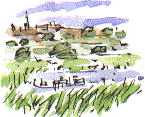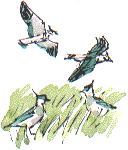
Whale WalkerThursday 6th July 2000I wrote up today's diary as a press release; Avian Polygamist touches down at Horbury AT THIS TIME it should be nesting on the tundra, perching on the back of a
whale or be on it's way to winter quarters off west Africa or South America.
Birdwatchers have been flocking to a marshy field, the Wyke, between the
canal and the River Calder at Horbury to see one of Yorkshire's rarest bird
passage migrants, the Grey Phalarope (I hope to include a sketch later).
AT THIS TIME it should be nesting on the tundra, perching on the back of a
whale or be on it's way to winter quarters off west Africa or South America.
Birdwatchers have been flocking to a marshy field, the Wyke, between the
canal and the River Calder at Horbury to see one of Yorkshire's rarest bird
passage migrants, the Grey Phalarope (I hope to include a sketch later).It's a bird famous for its women's lib, single parent lifestyle. The female has the brighter plumage and, unlike most birds, it is she who does the displaying. Once she has laid a clutch of eggs she leaves the male to take care of the incubation, while she finds another male and lays another clutch.  'Most avian polygamists are male,' writes Sir David Attenborough in The
Life of Birds, 'but in a very few instances it is the female who has
multiple mates.' Describing the female red-necked phalarope he writes; 'In
one season , she may have as many as four mates and four families of
chicks.'
'Most avian polygamists are male,' writes Sir David Attenborough in The
Life of Birds, 'but in a very few instances it is the female who has
multiple mates.' Describing the female red-necked phalarope he writes; 'In
one season , she may have as many as four mates and four families of
chicks.'www.birdguides.com carried this message today; 12:37 *W.YORKS GREY PHAL 4MLS SW.OF WAKEFIELD AT HORBURY WYKE. PK AT HORBURY BRDG BY BINGLEY ARMS PUB & WALK ALONG CALDER & HEBBLE CANAL TO SE.293.173. By late afternoon some sixty birdwatchers were in the area. One enthusiast said he'd travelled 200 miles to see the bird. It was still on a pool on a marshy field know as the Wyke at nine this evening. 
 It is brick red with black and white head and back plumage. It's rare to see
them in Britain in their summer colours. It gets its name because we usually
see them in grey winter plumage. The name phalarope means 'coot's feet' in
Greek and, like the coot, it has partially webbed feet. At the Wyke it swam in
circles in shallow water continually picking up aquatic insects that it
disturbed. Out at sea, where they spend most of their time outside the
nesting season, small flocks of grey phalaropes have been seen to land on
the backs of whales to feed on hard-shelled parasites.
It is brick red with black and white head and back plumage. It's rare to see
them in Britain in their summer colours. It gets its name because we usually
see them in grey winter plumage. The name phalarope means 'coot's feet' in
Greek and, like the coot, it has partially webbed feet. At the Wyke it swam in
circles in shallow water continually picking up aquatic insects that it
disturbed. Out at sea, where they spend most of their time outside the
nesting season, small flocks of grey phalaropes have been seen to land on
the backs of whales to feed on hard-shelled parasites.Grey Phalaropes are normally seen in Britain only on the spring or autumn migration. It's rare for them to come inland.    A few years ago this field was earmarked as a possible route for M1/M62
motorway link. This stretch of the Calder valley is one of Wakefield's best kept wildlife secrets, with 100 species of birds recorded, including snipe, reed bunting and teal. Part of the valley is
still threatened by plans for gravel extraction. Let's hope this rare visitor helps put it on the map as a wildlife habitat.
A few years ago this field was earmarked as a possible route for M1/M62
motorway link. This stretch of the Calder valley is one of Wakefield's best kept wildlife secrets, with 100 species of birds recorded, including snipe, reed bunting and teal. Part of the valley is
still threatened by plans for gravel extraction. Let's hope this rare visitor helps put it on the map as a wildlife habitat.
|